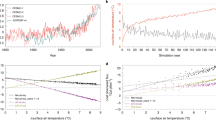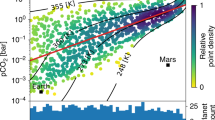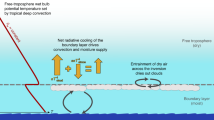Abstract
Determining the behaviour of convection and clouds is one of the biggest challenges in our understanding of exoplanetary climates. Given the lack of in situ observations, one of the most preferable approaches is to use cloud-resolving or cloud-permitting models (CPM). Here we present CPM simulations in a quasi-global domain with high spatial resolution (4 × 4 km2 grid) and explicit convection to study the cloud regime of 1:1 tidally locked rocky planets orbiting around low-mass stars. We show that the substellar region is covered by deep convective clouds and cloud albedo increases with increasing stellar flux. The CPM produces relatively lower cloud liquid water concentration, smaller cloud coverage, lower cloud albedo and deeper H2O spectral features than previous general circulation model simulations using empirical convection and cloud parameterizations. Furthermore, cloud streets—long bands of low-level clouds oriented nearly parallel to the direction of the mean boundary-layer winds—appear in the CPM and substantially affect energy balance and surface precipitation at a local level.
This is a preview of subscription content, access via your institution
Access options
Access Nature and 54 other Nature Portfolio journals
Get Nature+, our best-value online-access subscription
$29.99 / 30 days
cancel any time
Subscribe to this journal
Receive 12 digital issues and online access to articles
$119.00 per year
only $9.92 per issue
Buy this article
- Purchase on Springer Link
- Instant access to full article PDF
Prices may be subject to local taxes which are calculated during checkout






Similar content being viewed by others
Data availability
All model output data used in this paper can be found in the public storage https://doi.org/10.5281/zenodo.7226615.
Code availability
SAM can be downloaded from http://rossby.msrc.sunysb.edu/~marat/SAM.html, ExoCAM can be download from https://github.com/storyofthewolf/ExoCAM, CAM3 can be downloaded from https://www.cesm.ucar.edu/models/atm-cam/ and the transmission spectra module PSG can be found on https://psg.gsfc.nasa.gov/index.php. Code modifications for SAM and CAM3 can be found in the public storage of Harvard Dataverse: https://doi.org/10.7910/DVN/EM1NPX.
References
Hartmann, D. L. Global Physical Climatology (Elsevier Science, 2015).
Fauchez, T. J. et al. Impact of clouds and hazes on the simulated JWST transmission spectra of habitable zone planets in the TRAPPIST-1 System. Astrophys. J. 887, 194 (2019).
Fauchez, T. J. et al. The TRAPPIST-1 Habitable Atmosphere Intercomparison (THAI). III: Simulated observables–the return of the spectrum. Planet. Sci. J. 3, 213 (2022).
Komacek, T. D., Fauchez, T. J., Wolf, E. T. & Abbot, D. S. Clouds will likely prevent the detection of water vapor in JWST transmission spectra of terrestrial exoplanets. Astrophys. J. 888, L20 (2020).
Suissa, G. et al. Dim prospects for transmission spectra of ocean earths around M stars. Astrophys. J. 891, 58 (2020).
Yang, J., Cowan, N. B. & Abbot, D. S. Stabilizing cloud feedback dramatically expands the habitable zone of tidally locked planets. Astrophys. J. Lett. 771, L45 (2013).
Turbet, M. et al. The habitability of Proxima Centauri b-II. Possible climates and observability. Astron. Astrophys. 596, A112 (2016).
Kopparapu, R. K. et al. The inner edge of the habitable zone for synchronously rotating planets around low-mass stars using general circulation models. Astrophys. J. 819, 84 (2016).
Kopparapu, R. K. et al. Habitable moist atmospheres on terrestrial planets near the inner edge of the habitable zone around M dwarfs. Astrophys. J. 845, 5 (2017).
Boutle, I. A. et al. Exploring the climate of Proxima B with the Met Office Unified Model. Astron. Astrophys. 061, A120 (2017).
Bin, J., Tian, F. & Liu, L. New inner boundaries of the habitable zones around M dwarfs. Earth Planet. Sci. Lett. 492, 121–129 (2018).
Way, M. J. et al. Climates of warm Earth-like planets. I: 3-D model simulations. Astrophys. J. Suppl. 239, 24 (2018).
Hammond, M. & Pierrehumbert, R. T. Wave-mean flow interactions in the atmospheric circulation of tidally locked planets. Astrophys. J. 869, 65 (2018).
Del Genio, A. D. et al. Habitable climate scenarios for Proxima Centauri B with a dynamic ocean. Astrobiology 19, 99–125 (2019).
Wei, M., Zhang, Y. & Yang, J. Small sensitivity of the simulated climate of tidally locked aquaplanets to model resolution. Astrophys. J. 898, 156 (2020).
Sergeev, D. E. et al. The TRAPPIST-1 Habitable Atmosphere Intercomparison (THAI). Part II: Moist cases–the two waterworlds. Planet. Sci. J. 3, 212 (2022).
Khairoutdinov, M. F. & Randall, D. A. Cloud resolving modeling of the ARM Summer 1997 IOP: model formulation, results, uncertainties, and sensitivities. J. Atmos. Sci. 60, 607–625 (2003).
Haqq-Misra, J. et al. Demarcating circulation regimes of synchronously rotating terrestrial planets within the habitable zone. Astrophys. J. 852, 67 (2018).
Sergeev, D. E. et al. Bistability of the atmospheric circulation on TRAPPIST-1e. Planet. Sci. J. 3, 214 (2022).
Collins, W. D. et al. Description of the NCAR Community Atmosphere Model (CAM 3.0). NCAR Techical Note NCAR/TN-464+STR (University Corporation for Atmospheric Research, 2014); https://doi.org/10.5065/D63N21CH
Wolf, E. T., Kopparapu, R., Haqq-Misra, J. & Fauchez, T. J. ExoCAM: a 3D climate model for exoplanet atmospheres. Planet. Sci. J. 3, 7 (2022).
de Boer, G. et al. A characterization of the present-day arctic atmosphere in CCSM4. J. Clim. 25, 2676–2695 (2012).
Yang, J. et al. Differences in water vapor radiative transfer among 1D models can significantly affect the inner edge of the habitable zone. Astrophys. J. 826, 222 (2016).
Yang, J. et al. Simulations of water vapor and clouds on rapidly rotating and tidally locked planets: a 3D model intercomparison. Astrophys. J. 875, 46 (2019).
Lefèvre, M., Turbet, M. & Pierrehumbert, R. 3D convection-resolving model of temperate, tidally locked exoplanets. Astrophys. J. 913, 101 (2021).
Brown, R. A. Longitudinal instabilities and secondary flows in the planetary boundary layer: a review. Rev. Geophys. 18, 683–697 (1980).
Brummer, B. & Pohlmann, S. Wintertime roll and cell convection over Greenland and Barents Sea regions: a climatology. J. Geophys. Res. Atmos. 105, 15559–15566 (2000).
Gryschka, M. & Raasch, S. Roll convection during a cold air outbreak: alarge eddy simulation with stationary model domain. Geophys. Res. Lett. 32, L14805 (2005).
Etling, D. & Brown, R. A. Roll vortices in the planetary boundary layer: a review. Bound. Layer. Meteorol. 65, 215–248 (1993).
Atkinson, B. W. & Zhang, J. W. Mesoscale shallow convection in the atmosphere. Rev. Geophys. 34, 403–431 (1996).
Asai, T. Stability of a plane parallel flow with variable vertical shear and unstable stratification. J. Meteorol. Soc. Jpn 48, 129–139 (1970).
Pierrehumbert, R. T. Thermostats, radiator fins, and the local runaway greenhouse. J. Atmos. Sci. 52, 1784–1806 (1995).
Zhang, X., Tian, F., Wang, Y., Dudhia, J. & Chen, M. Surface variability of short-wavelength radiation and temperature on exoplanets around M dwarfs. Astrophys. J. 837, L27 (2017).
Sergeev, D. E. et al. Atmospheric convection plays a key role in the climate of tidally locked terrestrial exoplanets: insights from high-resolution simulations. Astrophys. J. 894, 84 (2020).
Song, X. & Yang, J. Asymmetry and variability in the transmission spectra of tidally locked habitable planets. Front. Astron. Space 8, 134 (2021).
Pidhorodetska, D. et al. Detectability of molecular signatures on TRAPPIST-1e through transmission spectroscopy simulated for future space-based observatories. Astrophys. J. Lett. 898, L33 (2020).
Loftus, K. & Wordsworth, R. The physics of falling raindrops in diverse planetary atmospheres. J. Geophys. Res. Planets 126, e2020JE006653 (2021).
Schneider, T., Kaul, C. M. & Pressel, K. G. Possible climate transitions from breakup of stratocumulus decks under greenhouse warming. Nat. Geosci. 12, 163–167 (2019).
Grimm, S. L. et al. The nature of the TRAPPIST-1 exoplanets. Astron. Astrophys. 613, A68 (2018).
Dressing, C. D. et al. Characterizing K2 candidate planetary systems orbiting low-mass stars II. Planetary systems observed during campaigns 1–7. Astron. J. 154, 207 (2017).
Gilbert, E. A. et al. The first habitable-zone Earth-sized planet from TESS. I. Validation of the TOI-700 system. Astron. J. 160, 116 (2020).
Bretherton, C. S. & Khairoutdinov, M. F. Convective self-aggregation feedbacks in near-global cloud-resolving simulations of an aquaplanet. J. Adv. Model. Earth Syst. 7, 1765–1787 (2015).
Vallis, G. F. Essentials of Atmospheric and Oceanic Dynamics (Cambridge University Press, 2019); https://doi.org/10.1017/9781107588431
Soong, S.-T. & Ogura, Y. Response of tradewind cumuli to large-scale processes. J. Atmos. Sci. 37, 2035–2050 (1980).
Li, X. et al. Large-scale forcing and cloud–radiation interaction in the tropical deep convective regime. J. Atmos. Sci. 56, 3028–3042 (1999).
Khairoutdinov, M. F. & Emanuel, K. Intraseasonal variability in a cloud-permitting near-global equatorial aquaplanet model. J. Atmos. Sci. 75, 4337–4355 (2018).
Neale, R. B. & Hoskins, B. J. A standard test for AGCMs including their physical parametrizations: I: The proposal. Atmos. Sci. Lett. 1, 101–107 (2000).
Goldblatt, C., McDonald, V. L. & McCusker, K. E. Earth’s long-term climate stabilized by clouds. Nat. Geosci. 14, 143–150 (2021).
Koll, D. D. B. & Abbot, D. S. Deciphering thermal phase curves of dry, tidally locked terrestrial planets. Astrophys. J. 802, 21 (2015).
Villanueva, G. L. et al. Planetary Spectrum Generator: an accurate online radiative transfer suite for atmospheres, comets, small bodies and exoplanets. J. Quant. Spectrosc. Radiat. Trans. 217, 86–104 (2018).
Acknowledgements
We thank M. F. Khairoutdinov for the release of the model SAM, E. T. Wolf for the release of the model ExoCAM and G. Villanueva for the release of the tool PSG. We are grateful for the helpful discussions with D. D. B. Koll, B. Yang, H. Yang, D. S. Abbot, N. Jeevanjee, C. Li and S. Fu. We thank J. Nie for his help in installing the model SAM on Tianhe-2. Z.F. was supported by the National Natural Science Foundation of China (NSFC) under grant no. 42175065, and J.Y. was supported by NSFC under grant nos. 42075046, 41888101 and 42161144011. In total, about 5 × 106 core hours have been used in the experiments. This corresponds to CO2 emission of ~8,000 kg, if we assume the power per core is 3.7 W and the carbon emission intensity is ~0.7 kg kWh−1.
Author information
Authors and Affiliations
Contributions
J.Y. led this project. J.Y., Z.F. and Y.Z. designed the experiments. Y.Z. modified the model SAM and performed most of the SAM experiments. M.Y. carried out the six quasi-global cloud feedback experiments using SAM. J.Y. performed the CAM3 experiments. Y.Z. performed the ExoCAM experiments. X.S. calculated the observational characteristics. J.L. carried out the episodic deluge analyses. Y.Z., M.Y., X.S. and M.W. plotted the figures. F.D. and Z.T. contributed to the convection analyses. All authors discussed the results. J.Y. wrote the draft, and all authors improved the manuscript.
Corresponding author
Ethics declarations
Competing interests
The authors declare no competing interests.
Peer review
Peer review information
Nature Astronomy thanks Denis Sergeev and the other, anonymous, reviewer(s) for their contribution to the peer review of this work.
Additional information
Publisher’s note Springer Nature remains neutral with regard to jurisdictional claims in published maps and institutional affiliations.
Supplementary information
Supplementary Information
Supplementary Discussion, Supplementary Tables 1–4, Supplementary Figs 1–21 and 26 references.
Supplementary Video 1
Time variability of the vertically integrated cloud liquid and ice water amount (g m−2) in the simulation of TRAPPIST-1e with a horizontal resolution of 4 km. The time interval of each frame is 1 h.
Supplementary Video 2
Time variability of the vertically integrated cloud liquid and ice water amount (g m−2) in the simulation of K2-72e. This video is the same as Supplementary Video 1, but for the planet K2-72e.
Supplementary Video 3
Time variability of the vertically integrated cloud liquid and ice water amount (g m−2) in the simulation of TRAPPIST-1e. This video is the same as Supplementary Video 1, but the simulation uses a higher resolution of 2 km.
Rights and permissions
Springer Nature or its licensor (e.g. a society or other partner) holds exclusive rights to this article under a publishing agreement with the author(s) or other rightsholder(s); author self-archiving of the accepted manuscript version of this article is solely governed by the terms of such publishing agreement and applicable law.
About this article
Cite this article
Yang, J., Zhang, Y., Fu, Z. et al. Cloud behaviour on tidally locked rocky planets from global high-resolution modelling. Nat Astron 7, 1070–1080 (2023). https://doi.org/10.1038/s41550-023-02015-8
Received:
Accepted:
Published:
Issue Date:
DOI: https://doi.org/10.1038/s41550-023-02015-8



